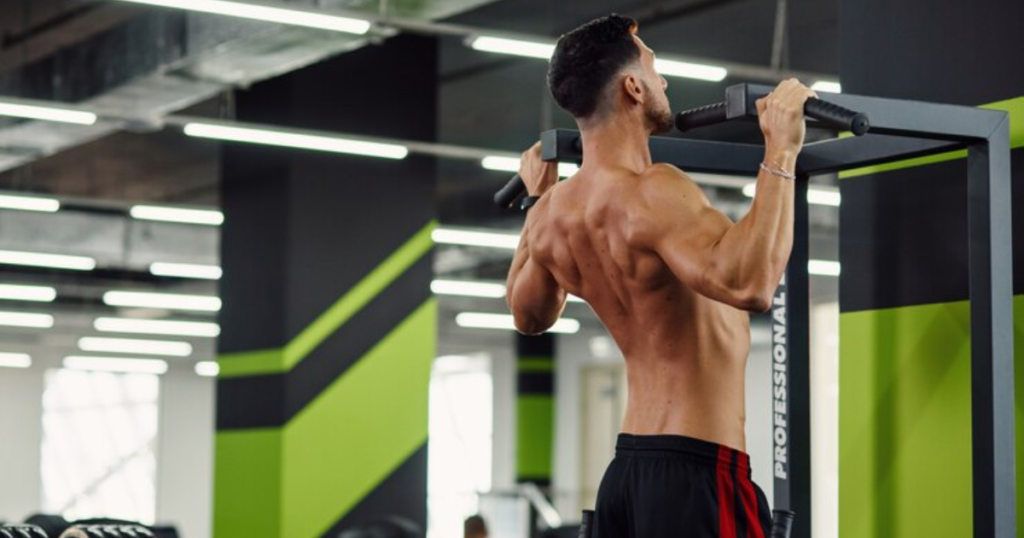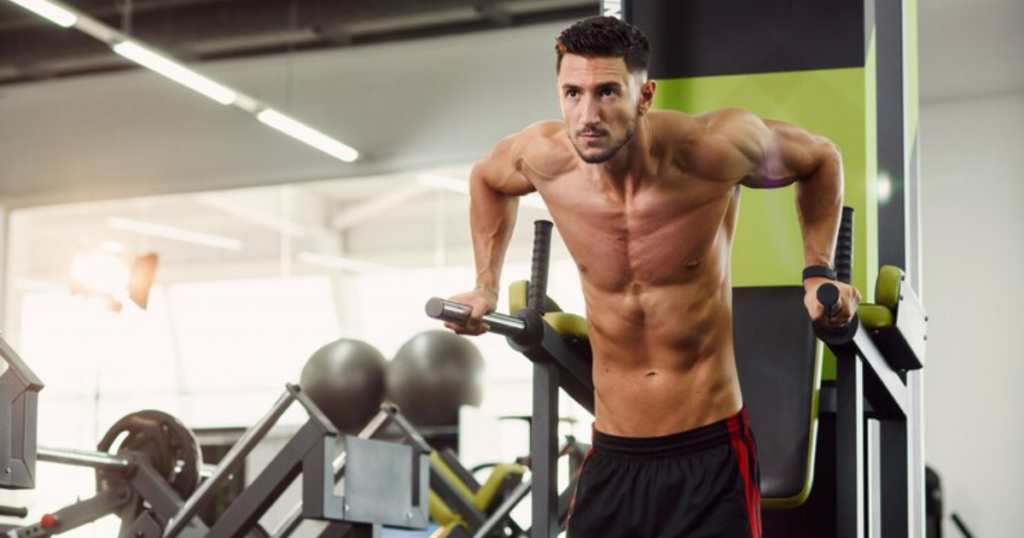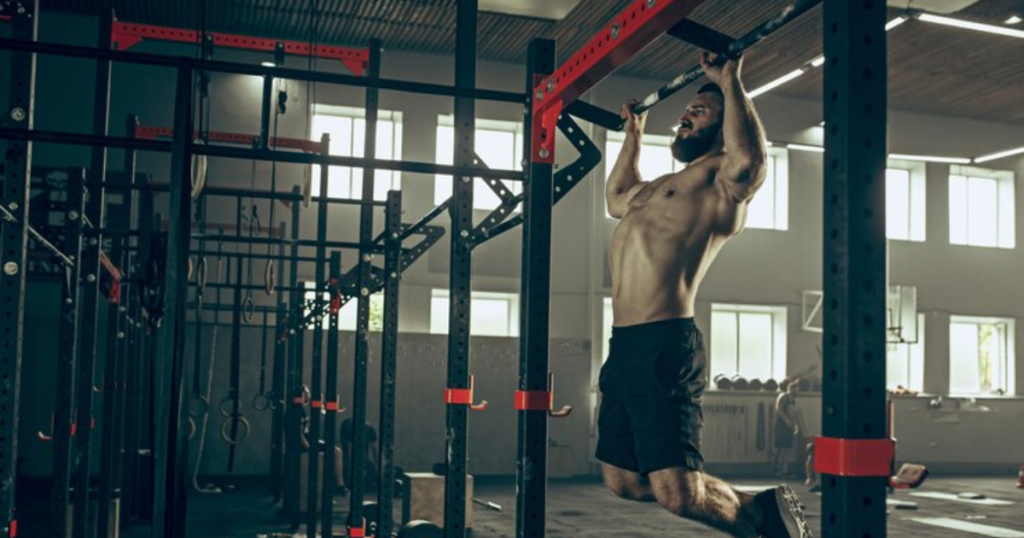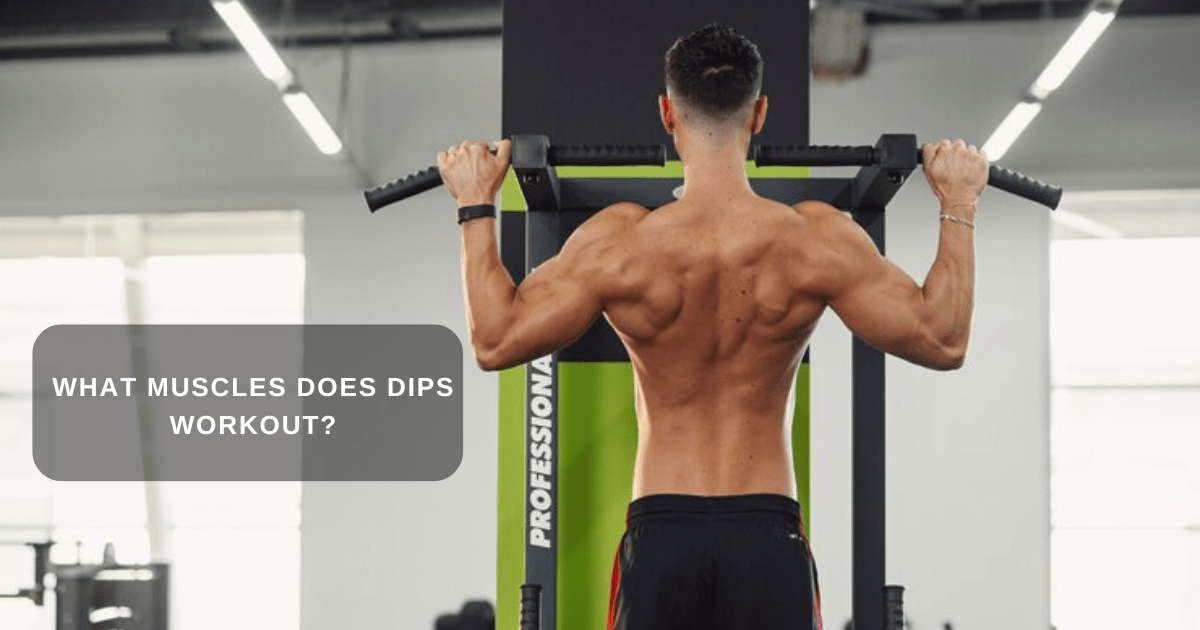If you want to make your arms and chest stronger and get bigger muscles, you can do dips. Dips are when you lower your body down and push yourself back up using your arms. They’re good for anyone who goes to the gym a lot or if you’re new to exercising. Dips work lots of muscles at the same time and are really helpful for your workout.
What is A Dip?
Dips are a complex exercise that primarily works the chest, shoulders, and triceps. Dips target numerous muscle groups by supporting your body weight with your arms while hanging between two parallel bars or on a bench, providing a complete upper body workout. It can assist develop strength, muscle definition, and upper-body stability.
Types of Dips and How to Do Them?
1. Parallel Bar Dips
Parallel bar dips, commonly known as triceps dips, are a traditional bodyweight exercise that works the triceps while simultaneously engaging the chest and shoulders. Here’s how to do parallel bar dips effectively.
How to Do:
- Stand between two parallel bars, arms extended, hands clutching the bars.
- Bend your elbows to bring your upper arms parallel to the ground or slightly lower.
- Keep your chest high and your shoulders back throughout the exercise.
- Straighten your arms by pushing through your palms, then return to the beginning posture.
- Repeat the required number of times.
2. Bench Dips
Bench dips are a beginner-friendly type of dips that can be done on a stable bench or chair. This exercise focuses mostly on the triceps but also works the chest and shoulders. Follow these instructions to do bench dips correctly:
How to Do:
- Sit on the edge of a bench or chair, hands clutching the edge next to your hips.
- Walk your feet forward until your knees form a 90-degree angle and your heels land on the ground.
- Lower your body by bending your elbows until your upper arms are parallel to the ground.
- Keep your back tight to the bench and don’t arch it.
- Straighten your arms by pushing through your palms, then return to the beginning posture.
- Repeat the required number of times.
3. Ring Dips
Ring dips are an advanced type of dip that needs stability and coordination. It can help you challenge your muscles and build overall strength. Here’s how to do ring dips effectively:
How to Do:
- Hang gymnastic rings from an overhead bar and hold each one with an overhand grip.
- Fully extend your arms and lean slightly forward, keeping your feet off the ground.
- Bend your elbows to lower your body while remaining stable and in control.
- Descend until your shoulders are below your elbows, then push back up to the starting position.
- Maintain your body straight throughout the movement and avoid swinging.
- Repeat the required number of times.
4. Weighted Dips
Weighted dips are a more sophisticated variant of dips that use external resistance to boost intensity and challenge your muscles. It can help you gain muscle and strength. Here’s how to do weighted dips securely.
How to Do:
- A dipping belt or harness will help you secure a weight plate or dumbbell between your legs.
- Grip the parallel bars or rings with your hands and position yourself like you would for a standard dip.
- Bend your elbows to lower your body while remaining in control and stable.
- Descend until your upper arms are parallel to the ground or slightly lower.
- Straighten your arms by pushing through your palms, then return to the beginning posture.
- Repeat the appropriate number of times while keeping proper form.

What Muscles Does Dips Workout?
Primary Muscles
1. Chest (Pectoralis Major and Minor): Dips workout target the chest muscles strongly, especially when performed with a forward-leaning posture. This motion engages both the pectoralis major and minor muscles, promoting chest development and strength.
2. Shoulders (Anterior Deltoids): Dips put a significant pressure on your shoulders, particularly the anterior deltoids. These muscles control shoulder flexion and serve an important function in stabilizing the movement.
3. Triceps Brachii: Dips are well-known for their usefulness in targeting the triceps. The triceps brachii, positioned on the back of the upper arm, are highly engaged during dips’ pushing motion, which aids with elbow extension.
Secondary Muscles
1. Lats (Latissimus Dorsi): Although dips are not the major focus, they do engage the latissimus dorsi, also known as the lats. These vast muscles on the sides of the back help with shoulder extension and adduction during the upward part of the exercise.
2. Rhomboids: Dips require scapular retraction, which activates the rhomboid muscles located between the shoulder blades. Rhomboids muscle strengthening improves posture and stability in a variety of upper body actions.
3. Serratus Anterior: The serratus anterior, sometimes known as the “boxer’s muscle,” helps to protract the shoulder blades during the pushing phase of dips. This muscle involvement improves shoulder stability and upper-body strength.
Dips effectively activate numerous muscular groups at once, making them an excellent supplement to any strength training regimen. Dips encourage balanced muscular growth and functional strength because they target both primary and secondary muscles.

Variations of Dips
There are several variations of dips, each targeting slightly different muscle groups and offering varying levels of difficulty:
- Parallel Bar Dips: Using two parallel bars, typically found on dip stations, to perform the exercise.
- Bench Dips: Performing dips using a bench or chair to support your body weight.
- Ring Dips: Utilizing gymnastics rings to add instability and increase the challenge.
- Weighted Dips: Adding extra resistance with a weight belt or weighted vest to increase muscle overload.
How to Perform Dips Properly?
To perform dips correctly and maximize their effectiveness, follow these steps:
1. Equipment Needed:
- Parallel bars, dip station, or a stable elevated surface.
- Grip strength assistance (if required).
- For increased resistance, consider using a weight belt or dip belt.
2. Step-by-Step Instructions:
- Step 1: Begin by gripping the parallel bars or dip handles firmly, with your arms fully extended and your body suspended above the bars.
- Step 2: Lower your body by bending your elbows until your shoulders are below your elbows or at a comfortable depth.
- Step 3: Maintain a slight forward lean to engage the chest muscles, while keeping your core tight and back straight.
- Step 4: Push through your palms to extend your elbows and return to the starting position, fully extending your arms.
- Step 5: Repeat for the desired number of repetitions, ensuring controlled movement throughout the exercise.

Benefits of Including Dips in Your Workout Routine
Incorporating dips into your fitness regimen offers a myriad of benefits, including:
- Upper Body Strength: Dips work various upper body muscle groups, including the chest, shoulders, and triceps, resulting in increased strength and muscle definition.
- Muscle Hypertrophy: Dips promote muscular growth and hypertrophy by providing a rigorous resistance stimulus, resulting in increased muscle mass and size.
- Functional Fitness: Dips simulate pushing actions found in daily activities and sports, which improves overall functional fitness and movement patterns.
- Variety and Versatility: Dips can be performed with a variety of equipment and adapted to meet different fitness levels and goals, increasing the adaptability of your training regimen.
- Calisthenic Mastery: Mastering dips improves the fundamental skills needed for more advanced calisthenic workouts like muscle-ups and handstand push-ups.
Common Mistakes to Avoid During Dips
While dips are highly effective when performed correctly, certain mistakes can compromise their efficacy and increase the risk of injury. Common mistakes to avoid include:
- Overarching the Lower Back: Maintaining a neutral spine position during the action will help to prevent undue strain on the lower back.
- Incomplete Range of Motion: To fully engage the targeted muscles, lower your torso such that your shoulders are at or below your elbows.
- Flaring Elbows: Keep your elbows close to your body to relieve tension on the shoulder joints and concentrate your efforts on the triceps and chest muscles.
- Rushing the Movement: When performing dips, use calm, deliberate motions rather than swinging or jerking, which might reduce their effectiveness.
- Skipping Proper Warm-up: To lessen the chance of injury and increase performance, warm up your upper body muscles with dynamic stretches and mobility exercises before doing dips.
More: Top 9 Lat Workouts with Dumbbells
Takeaways
Dips are like a fun exercise that works many parts of your upper body, like your chest, shoulders, and arms. When you do dips during your workout, and you do them the right way while being careful, they can make you stronger and build more muscles in your upper body. It’s important to go easy at first, not push yourself too hard, and take breaks so you don’t hurt yourself.
Frequently Asked Questions
What muscles do dips workout?
Dips primarily workout the chest, shoulders, and triceps muscles. Imagine pushing yourself up from a chair or a bench with your arms; those are the muscles you’re working out!
Are dips good for building muscle?
Yes, dips are excellent for building muscle, particularly in the chest, shoulders, and triceps. They help to strengthen and define these muscles, which can be quite beneficial if you enjoy sports or simply want to feel stronger overall.
How do dips benefit my body?
Dips improve your body by targeting key muscles such as your chest, shoulders, and triceps. When you execute dips on a regular basis, you not only strengthen these muscles but also increase your entire upper body strength and endurance.
Can I do dips at home without equipment?
Yes, dips may be done at home without any equipment! Dips can be done on strong furniture such as chairs or tables. Simply make sure they’re stable and won’t tip over. It’s an excellent technique to work out your muscles without using expensive gym equipment.
How many dips should I do to see results?
Your fitness level and goals will determine how many dips you should do. Begin with a number that feels tough but manageable, such as three sets of eight to twelve reps. As you gain strength, you can gradually increase the amount of dips you perform.









Leave a Reply